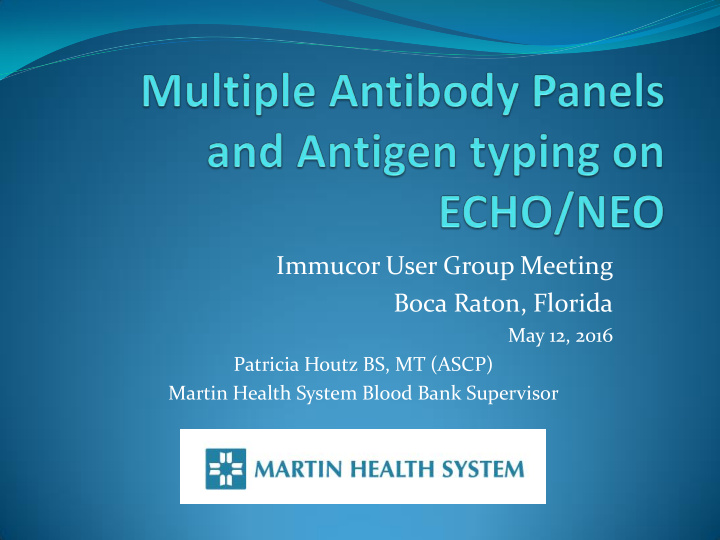



Immucor User Group Meeting Boca Raton, Florida May 12, 2016 Patricia Houtz BS, MT (ASCP) Martin Health System Blood Bank Supervisor
Objectives Describe Martin’s antibody resolution workflow Illustrate workflow using case studies Review how automated antigen typing is performed on the NEO and Echo to screen red cell units and the advantages of doing so.
Martin Health System Three Hospitals -450 beds One Free Standing Emergency Room More than 12,300 Transfusions annually 9,200 are Red Blood Cells Transfusions 13,050 Type and Screens 570 Antibody Identifications 2,700 AHG Crossmatches Echo/NEO 9,500 Electronic Crossmatches
Routine Protocol for Positive Antibody Screen New Patient with positive Antibody Screen Capture R Ready-ID and Extend-I/Extend-II Rh positive patient Extend-I Rh negative patient Extend-II Automated DAT (auto control) Patients with History of Antibodies Choose a panel or panels with the greatest number of negatives for the antibody the patient has. Automated DAT (auto control)
Case Study FW 74 Year Old Male Caucasian History of Anti-E, Anti-K, Anti-Fya, Anti-Jka, Anti-S and Anti-Kpa Gastric Antral Vascular Ectasia Gastric antral vascular ectasia (GAVE) syndrome, also known as watermelon stomach is a significant cause of acute or chronic gastrointestinal blood loss in the elderly. Presenting with occult blood loss leading to transfusion-dependent chronic iron-deficiency anemia, severe acute upper gastrointestinal bleeding, and nondescript abdominal pain. Multiple Transfusions from 2/2011 – 6/2014 ≈ 100 units of RBC’s have been given at Martin Medical Center. Jka has not been demonstrating Since 3/2011
Antibody Screen Type & Screen and Two Units of Red blood Cells to be transfused as an outpatient. Antibody Screen Results from Echo:
Ready-ID ** Two cells negative for all antibodies
Extend-II ** One cell negative for all antibodies
PeG Selected Cells
Patient Results Anti-Jsa identified and reported Automated DAT Negative Patient Results : Anti-E, Anti-K, Anti-Fya, Anti-Jka, Anti-S, Anti-Kpa and Anti-Jsa Two units ordered from Oneblood crossmatched on Echo- Compatible (AHG)
Case Study PE 44 year old Female Presented to the ER with dizziness and heavy vaginal bleeding for the past 4 days. She is hypotensive with a low grade fever. Laboratory Results: WBC 7.6 10*3/uL Hgb 4.9 g/dL Hct 16.8 % Plt 2 10*3/uL History of ITP and Uterine Fibroids with Menorrhagia History of Anti-E and Anti-S Three units of Red Blood Cells transfused 8/2015
Antibody Screen Type & Screen and Four Units of Red Blood Cells to be transfused Antibody Screen Results from Echo:
Ready-ID
Extend-I
Ready-ID Rule Outs
Extend-I Rule outs With the Two Panels Can not Rule out- Jkb, M, K Low-incidence antibody's that cannot be ruled out Cw, V, Jsa and Kpa
2 nd Ready-ID to Rule out M
PeG Selected Cells
PeG Selected Cells rule out K and Cw
Patients Results Patient Antigen Typed For Jkb - Negative Automated DAT- Negative Anti-Jkb identified Patients Resulted As: Anti-E, Anti-S & Anti-Jkb Antigen Screening of Donor Units Performed on NEO and Echo Six units Crossmatched on Echo Compatible (AHG)
Antigen Typing on Echo/NEO
QC ECHO/NEO With Approved Reagents QC performed every 24hours Echo QC can be performed with patient/donor samples. NEO QC has to be performed and Qualified before patient/donor samples. All Patient and donor results can be transmitted to the LIS for Verification. Print and Review QC results.
Materials Needed ECHO Specimen diluent (small 10ml bottle) Antisera- E, e, C, c, K CMT strips QC: WB corQC C- Levels 2 & 4 c- Levels 1 & 4 E- Levels 2 & 4 e- Levels 3 & 4 K- Levels 1 & 4 Bring all reagents to Room Temperature.
Materials Needed NEO Specimen diluent (large 57ml bottle) Antisera- E, e, C, c, K CMT strips Cor QC Extend 1,2,3, & 4 Bring all reagents to Room Temperature.
Antigen Screening On NEO Jka, Jkb, Fya, S and s Monoclonal Reagents NOT APPROVED for Test of Record Must be Validated by facility Instrument- 50 samples Follow the package insert for assay method (RT or AHG) Room Temperature- 30 minutes mAgScrRT AHG- 44 minutes pAgScrAHG With all batches a known positive and negative donor is run. Jka and Jkb all negatives are confirmed by tube method with positive and negative controls.
Antigen Screening on NEO S, s and Fya we report from the NEO manual entry into the LIS QC is performed by tube method using the weakest expression of the antigen (heterozygous). Antisera is aliquoted into a 12x75 tube Used Straight Labeled with the Antigen being tested Labeled with Lot# and expiration date
Benefits of Screening Donors on Echo/Neo Automation saves Tech Time Uses Smaller sample size Less Reagent All results can be transmitted to the LIS for Verification Medical Center keeps inventory of antigen negative units, to distribute to the other sites and to reduce antigen screening on off shifts. Approximately 40 to 50 O positive units Screen at a time Approximately 5 to 10 O negative units Screen Turn around time (reference lab 2hours away) Cost savings
Recommend
More recommend